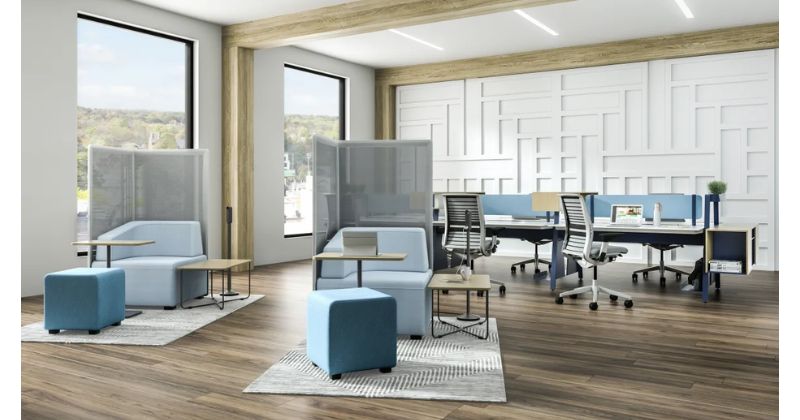Choosing the right office visiting chair is crucial for ensuring comfort and making a positive impression on guests. To streamline your decision-making process, here are seven quick tips to consider before making a purchase:
1. Assess Comfort and Ergonomics
Comfort is paramount when selecting a visitor chair. Since guests might spend varying amounts of time in these chairs, prioritize features that enhance comfort:
-
Seat Padding: Look for chairs with high-density foam or gel cushioning for a comfortable seating experience. The padding should be firm enough to support prolonged sitting without causing discomfort.
-
Back Support: An ergonomic backrest that supports the natural curve of the spine can prevent back strain. Consider chairs with adjustable lumbar support to accommodate different body types and preferences.
-
Armrests: Opt for chairs with padded armrests. Adjustable armrests can add flexibility and accommodate different user preferences. Ensure they are positioned at a height that allows guests to relax their arms comfortably.
2. Consider Chair Material
The material of the chair affects both comfort and maintenance:
-
Upholstery Options: Common materials include leather, faux leather, mesh, and fabric. Leather and faux leather are easy to clean and offer a sleek look but can be less breathable. Mesh provides better airflow, which can be beneficial in warm environments, but may lack cushioning. Fabric is cozy but might require more frequent cleaning.
-
Durability: Ensure the material is durable enough to withstand regular use. High-quality materials generally last longer and maintain their appearance better over time.
3. Check Size and Dimensions
The size of the chair should fit the available space and accommodate various body types comfortably:
-
Seat Dimensions: The seat should be wide and deep enough to provide ample space without feeling cramped. Typically, a seat width of at least 18 inches and a depth that allows for proper support while leaving a few inches between the back of the knees and the seat edge are ideal.
-
Overall Size: Ensure the chair’s dimensions fit well within your office layout. Oversized chairs can make small spaces feel cramped, while too-small chairs may look out of place in larger areas.
4. Test for Adjustability
Adjustable features enhance flexibility and comfort:
-
Height Adjustment: A chair with adjustable seat height ensures that guests can easily reach a comfortable sitting position, especially in offices with varying desk heights.
-
Backrest Tilt: Some chairs offer adjustable backrest tilt or recline features. While this may be less critical for visitor chairs compared to task chairs, it can still add an extra level of comfort for longer visits.
-
Armrest Adjustments: Adjustable armrests can help guests find the most comfortable position for their arms, reducing strain and increasing overall comfort.
5. Evaluate Aesthetic and Design
The chair’s design should complement your office’s decor:
-
Style: Choose a chair style that matches the overall look of your office. Whether your office has a modern, traditional, or eclectic style, select chairs that enhance the existing decor and create a cohesive environment.
-
Color: Opt for colors that blend well with your office’s color scheme. Neutral colors like black, gray, or beige are versatile and can integrate easily with various office designs.
6. Consider Maintenance and Durability
Visitor chairs should be easy to maintain and built to last:
-
Cleaning Ease: Select materials that are simple to keep clean and care for. Leather and faux leather typically require simple wiping, while fabric may need regular vacuuming or professional cleaning.
-
Build Quality: Look for chairs with sturdy frames and high-quality construction. A well-built chair is more likely to withstand regular use and maintain its appearance over time. Check for warranties or guarantees to ensure durability.
7. Set a Budget and Compare Options
Making a budget guarantees you receive the best value for your money and helps you narrow down your options:
-
Budget Range: Determine how much you are willing to spend and try to stick within that range. While higher-priced chairs may offer better comfort and durability, there are many cost-effective options that provide good value.
-
Compare Features: Once you have a budget, compare different chairs based on features, materials, and design. Look for the best combination of comfort, style, and durability within your price range.
Conclusion
Selecting the right office visiting chair involves balancing comfort, style, and practicality. By assessing comfort and ergonomics, considering materials, checking dimensions, testing adjustability, evaluating design, considering maintenance, and setting a budget, you can make an informed choice that enhances your office environment and ensures a pleasant experience for your guests. Taking the time to choose the right chair will not only improve the comfort of your visitors but also contribute to a professional and welcoming office atmosphere.
For more insightful articles related to this topic, feel free to visit- ( Click Here )

